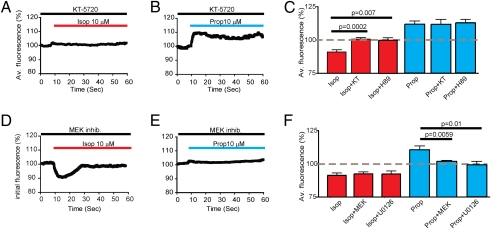Fig. 2.
β-Adrenergic receptor–mediated calcium-signaling effects are distinguishable by their dependence on PKA or the MEK/ERK cascade. (A) Average calcium indicator fluorescence intensity was measured in pyramidal neurons preincubated with the specific PKA inhibitor KT-5720 (1 μM; black line) before and after bath application of isoproterenol (10 μM; red line). (B) Fluorescence intensity measured similarly in response to 10 μM propranolol (blue line). (C) Analysis across multiple experiments of fluorescence intensities measured at 5 s after the addition of the indicated adrenergic ligand, verifying that the isoproterenol-induced decrease in calcium fluorescence (Isop) was prevented by KT-5720 (Isop + KT), as well as by the chemically distinct PKA inhibitor H89 (Isop + H89) (n = 6 and n = 7, respectively). The propranolol-induced increase in calcium indicator fluorescence (Prop) was not significantly different in the presence of either KT-5720 (Prop + KT) or H89 (Prop + H89). Each bar represents the mean ± SEM of average fluorescence changes (relative to basal levels) across between six and eight experiments. (D and E) Effect of the MEK/ERK inhibitor mixture on the ability of isoproterenol (D) and propranolol (E) to change calcium indicator fluorescence, using the same experimental design as in A and B. (F) Analysis across multiple experiments of calcium indicator fluorescence measured at 5 s after adrenergic ligand addition, verifying that the MEK/ERK inhibitor mixture (Isop + MEK) and the selective MEK inhibitor U0126 (Isop + U0126) did not affect the isoproterenol-induced decrease of calcium indicator fluorescence, but did inhibit the propranolol-induced increase (n = 6–8 experiments for each condition).

